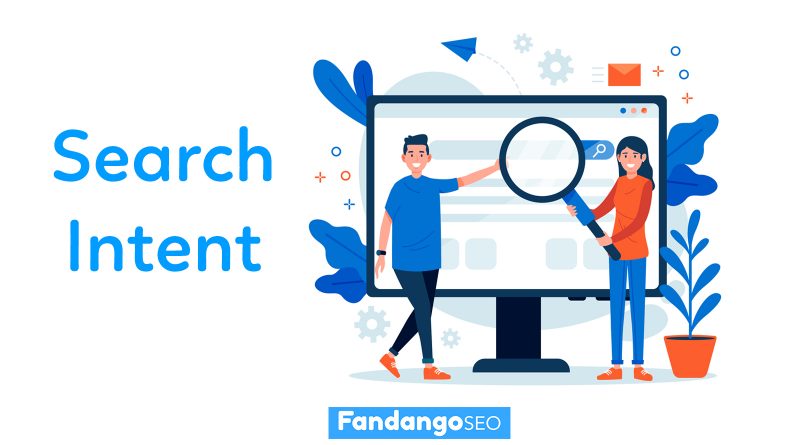Analyze Search Intent Instantly
Knowing the searcher intent behind target keywords can make your search campaign more effective and efficient.
Do you or your team spend a lot of time in spreadsheets manually finding and tagging types of user intent labels to all of your keyword lists?
Manual spreadsheet work no more.
Seotoolbuy.com just released a new search intent filter and added it to all of our award-winning keyword-based reports.
This allows you to immediately see the intent (or intents) of any keyword as you research keywords & domains, and track positions.
At this time, no other major SEO software offers a solution for search intent optimization every step of the way like Seotoolbuy now does.
What Can You Do Now?
You can now instantly see keywords on Semrush labeled with an intent. You can filter entire reports by intent, like in the Keyword Magic Tool pictured below.
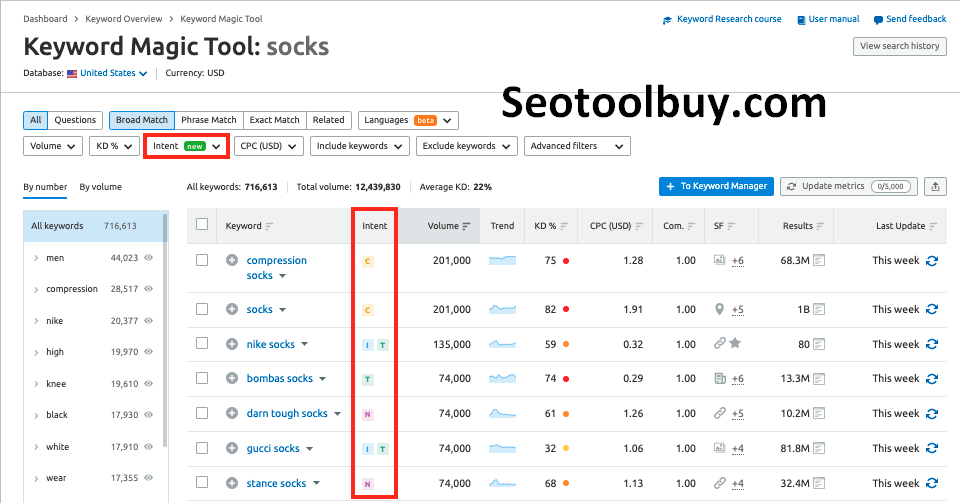
Or, study a competitor’s domain with a Domain Overview to study their keyword profile broken down by intent.
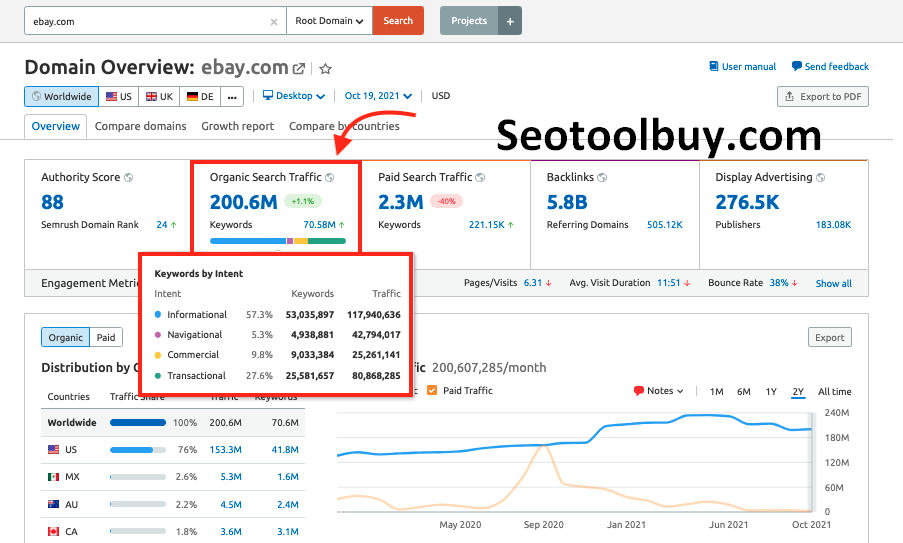
You can find the intent metric in all of these tools:
- Domain Overview
- Organic Research
- Position Tracking
- Keyword Overview
- Keyword Gap
- Keyword Magic Tool
- Keyword Manager
Search intent categories and examples:
- Informational intent: searchers looking for an answer to a specific question or general information.
- “how to clean sneakers”
- Navigational intent: searchers intending to find a specific site or page.
- “vans sneakers”
- Commercial intent: searchers looking to investigate products, services, or brands. These commonly have an intent to complete an action or purchase sometime in the future.
- “best sneakers for walking”
- Transactional intent: searchers intending to complete an action or purchase (aka buyer intent keywords).
- “buy sneakers online”
At the end of this post, we’ll share examples of how to do research and search intent targeting with Semrush.
But first, let’s discuss why intent is such a valuable concept in SEO.
Why Search Intent Is So Important in SEO Keyword Research
Keyword intent or searcher intent is defined as being the underlying purpose behind an online query.
Simply put, search intent gives you the perspective you need to better understand your audience and market.
Matching a searcher’s intent query with the most relevant search results is also one of the top goals of Google.
As you optimize your content for search intent, it can lead to a more targeted audience finding your content which drives higher engagement and lowers bounce rates.
Chris Beck wrote on our blog that the SEO benefits of targeting intent can include:
- improved conversion rates on transaction pages
- reduced bounce rates
- more pageviews
- more answer boxes
- a wider audience reach.
Just like any other keyword research metric, search intent gives you another perspective on your audience.
Search volume shows you the popularity of questions and pain points in your market.
Keyword difficulty tells you which keywords would be the easiest queries to target based on who’s currently competing for that keyword’s traffic.
Search intent tells you how much engagement you could realistically expect from someone who used this search to land on your site.
Targeting Search Intent
Along with finding long-tail keywords and low-competition keywords, knowing the intent of your target keywords is a valuable data point to consider in the planning stage of any search campaign.
When you find a transactional target keyword, you can infer that people using these search terms have a higher intent to take action, and therefore convert on your site. For example, “where to buy a guitar” is a transactional search.
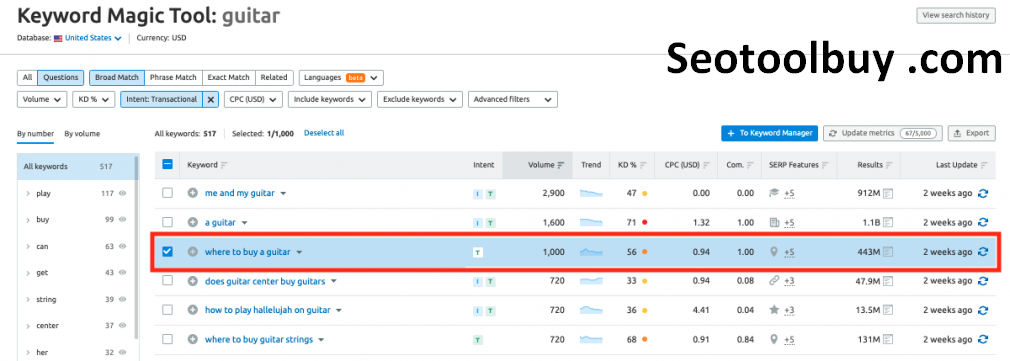
When you have a keyword tagged informational, you can infer people are interested in learning something or gathering info with their Google search. An example of this would be “how to tune a guitar.”
Even though informational search queries don’t explicitly represent someone in the buying cycle (like transactional queries do), they still represent opportunities to build your brand awareness.
That person searching for how to tune a guitar would become aware and appreciative of the brand that offers the most helpful video about tuning guitars.
Then, they could remember that brand in the future when looking for help purchasing a new guitar or guitar accessories.
With this knowledge, you can map your website marketing strategy to the right intent and serve people better content.
How Semrush Calculates Keyword Intent
To give each keyword an intent value, Semrush uses a machine-learning algorithm that looks into the following factors:
- SERP features present in keyword search results
- The presence of words in the keyword that indicate the mood/intention of the user (for example: buy, address, how)
- If the keyword is branded or not branded
All languages are supported by this intent metric.
However, for the 10 most popular languages (listed below), we added additional optimization to our algorithm that determine special anchors included within each keyword to understand intent more accurately
- English
- German
- French
- Spanish
- Italian
- Portuguese
- Danish
- Dutch
- Russian
- Swedish
Please note: A keyword can have more than one intent.
For example, informational intent keywords could also have a commercial intent or navigational intent depending on how the search is phrased. (See below, “12 string guitar” can have both informational and transactional intent).
5 Ways to Use Semrush Keyword Intent in Your Marketing
Want to know what you can do with this unique solution from Semrush?
Since the intent metric is now a key part of so many tools, here are some workflows to help you run better campaigns from the beginning to the end.
1. Run a Keyword Intent Competitive Analysis
In competitive research reports like Domain Overviewand Organic Research, you can look up a competitor and see the ratio of keyword intent types making up their keyword portfolio:
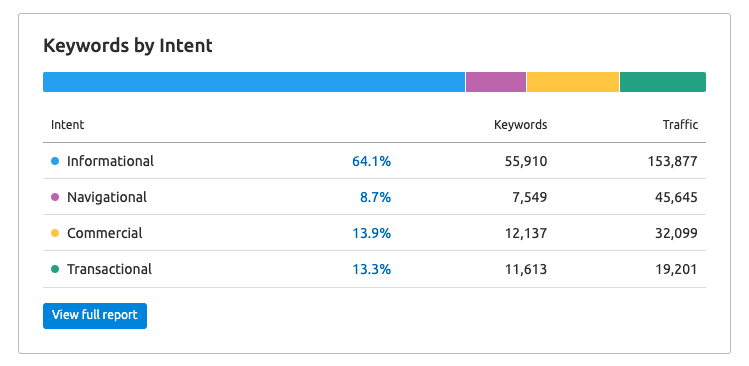
- Blue = Informational
- Purple = Navigational
- Yellow = Commercial
- Green = Transactional
From here, you can see the list of all of their keywords and then dive down into each intent.
See what kinds of keywords bring them the most traffic and filter to look at all of their transactional keywords.
Then, dive into their top pages in the Organic Research Pagestab. This shows you the list of pages bringing them the most organic traffic.
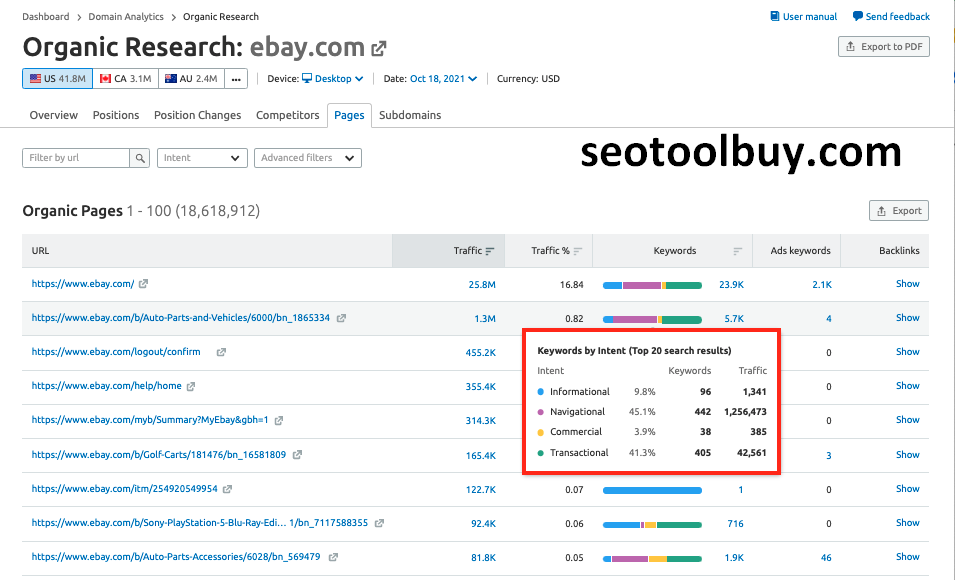
If you find a page on their site that inspires you or is similar to something on your site, check how it targets each type of intent.
Do their top pages have mostly informational keyword traffic, or navigational?
What kinds of pages bring more transactional and commercial traffic compared to informational traffic?
This kind of investigating could give you some new intent-based content ideas that could bring high intent traffic to your site.
2. Run a Keyword Gap Analysis
To take your competitive analysis to another level, you can run the Keyword Gap tool and filter by intent.
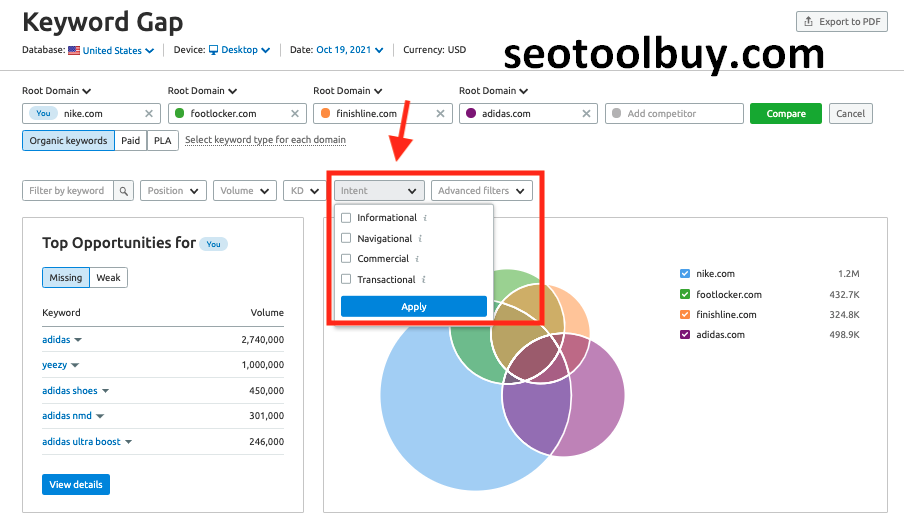
For example, filtering by transactional + “missing” will let you see those high intent keywords that your competitors are ranking for that you are not yet.

3. Use the Keyword Magic Tool to Find Low Difficulty + High Intent Keywords
To start finding high intent keywords, just enter a seed keyword related to your site into the Keyword Magic Tool and apply the filter.
Boom — now you can see which searches related to your main target query are transactional, commercial, informational, and navigational.

Since transactional and commercial keywords have the highest intent, they would make better targets for paid advertising or pages where your visitors can directly buy or take action on your site.
Next, to filter out everything that isn’t low difficulty, go to the KD% filter.
This lets you eliminate any keywords that have a high amount of competition in the organic results and would be too hard to go after with SEO.
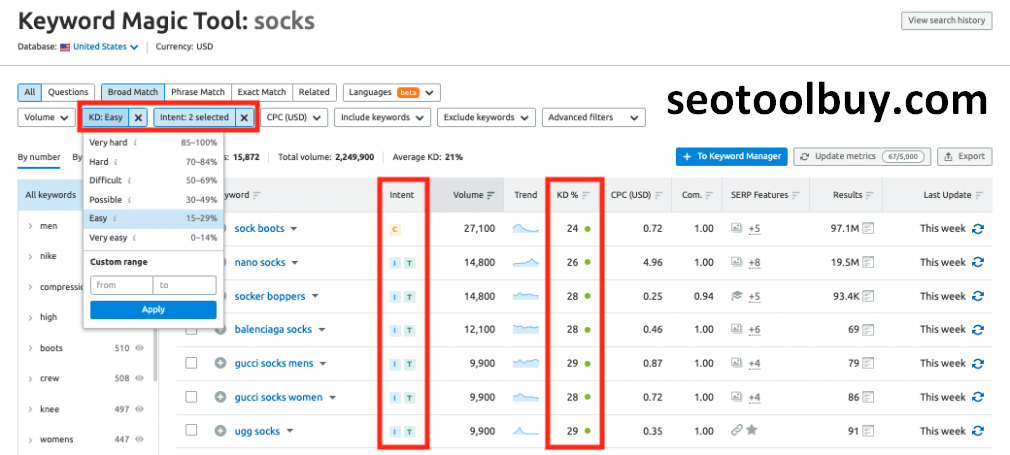
Set this filter to “Easy” or “Very Easy” and you’ll have a list of specific keywords that are low competition and high intent.
4. Map Keyword Intent Clusters to Your Marketing Strategy
Keyword intent mapping will make sure that your strategy focuses on the most important keywords and that you cover each stage of the buying journey with relevant content.
Once you identify which of your keywords fall into each bucket of intent, you can then target them accordingly.
Informational keywords: Provide educational content that answers questions and is easy to understand.
Navigational keywords: Make sure your site is visible for any searches that include your business name or brand
Commercial/transactional keywords: Advertise/promote your product or service pages by bidding on keywords with commercial and transactional search intent. Then, make it as clear and easy as possible to take action towards buying on those landing pages.
5. Track Growth Based on Search Intent with Position Tracking
Since the Position Tracking tool can now filter your custom list by intent, you can track your clusters of keyword intent separately.
To do so, just add a filter for intent to your Overview report and see how the data changes.
Here’s an example report filtered to only show keywords with transactional and commercial intent:

If you know the goals of your campaign are more focused on informational intent versus transactional (or vice versa), this could be a great way to point out your specific growth in a report.
One more place to check out search intent in Position Tracking would be the Pages tab. This report shows a list of your domain’s pages that rank for your campaign’s target keywords.
In the “Intent Rates” column, you’ll see an intent breakdown for each page.
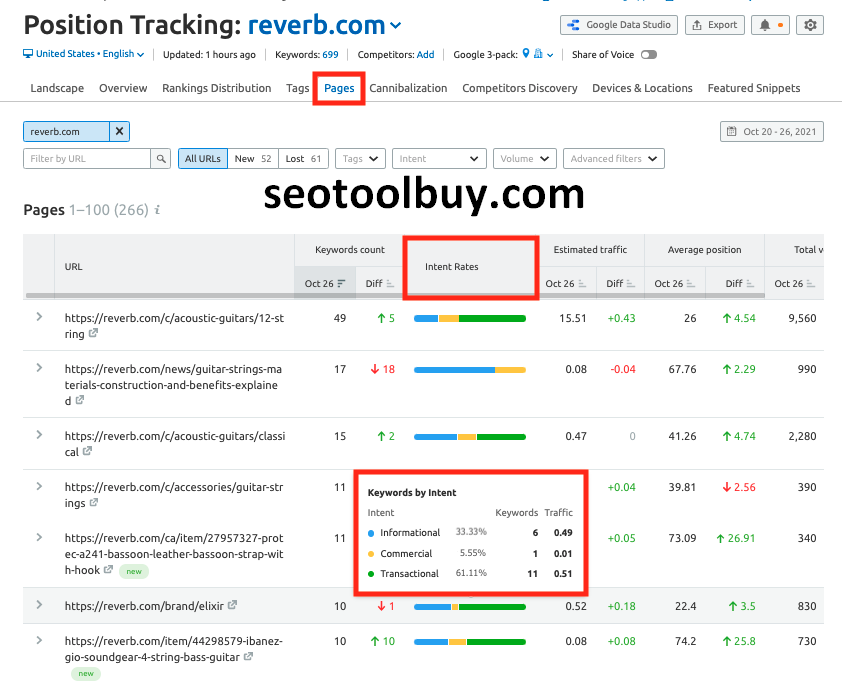
Generally speaking, this can help you understand which type of traffic (in terms of intent) goes to your domain’s pages and which of these types is working the best to bring your site traffic.
This knowledge may help users to make the content strategy more focused and more effective.
